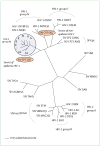HIV/AIDS epidemiology, pathogenesis, prevention, and treatment
- PMID: 16890836
- PMCID: PMC2913538
- DOI: 10.1016/S0140-6736(06)69157-5
HIV/AIDS epidemiology, pathogenesis, prevention, and treatment
Abstract
The HIV-1 pandemic is a complex mix of diverse epidemics within and between countries and regions of the world, and is undoubtedly the defining public-health crisis of our time. Research has deepened our understanding of how the virus replicates, manipulates, and hides in an infected person. Although our understanding of pathogenesis and transmission dynamics has become more nuanced and prevention options have expanded, a cure or protective vaccine remains elusive. Antiretroviral treatment has transformed AIDS from an inevitably fatal condition to a chronic, manageable disease in some settings. This transformation has yet to be realised in those parts of the world that continue to bear a disproportionate burden of new HIV-1 infections and are most affected by increasing morbidity and mortality. This Seminar provides an update on epidemiology, pathogenesis, treatment, and prevention interventions pertinent to HIV-1.
Conflict of interest statement
D D Ho sits on the scientific advisory boards for Monogram, Osel, Achillion, Valiant, Oyagen, Lavipharm, and XTL. Products or work from these companies are not discussed in the review. He holds patents on vaccine candidates. The other authors declare no conflict of interest.
Figures






Comment in
-
Non-sterile injections, contaminated blood, and the spread of HIV.Lancet. 2006 Sep 23;368(9541):1064-5. doi: 10.1016/S0140-6736(06)69435-X. Lancet. 2006. PMID: 16997655 No abstract available.
References
-
- UNAIDS. 2006 report on the global AIDS epidemic: a UNAIDS 10th anniversary special edition. [(accessed July 20, 2006)]. http://www.unaids.org/en/HIV_data/2006GlobalReport/default.asp.
-
- Inciardi JA, Williams ML. Editor’s introduction: the global epidemiology of HIV and AIDS. AIDS Care. 2005;17 (suppl 1):S1–8. - PubMed
-
- Hayes R, Weiss H. Epidemiology. Understanding HIV epidemic trends in Africa. Science. 2006;311:620–21. - PubMed
-
- Quinn TC, Overbaugh J. HIV/AIDS in women: an expanding epidemic. Science. 2005;308:1582–83. - PubMed
-
- Abdool-Karim Q, Abdool-Karim SS. The evolving HIV epidemic in South Africa. Int J Epidemiol. 2002;31:37–40. - PubMed
Publication types
MeSH terms
Substances
Grants and funding
LinkOut - more resources
Full Text Sources
Other Literature Sources
Medical

